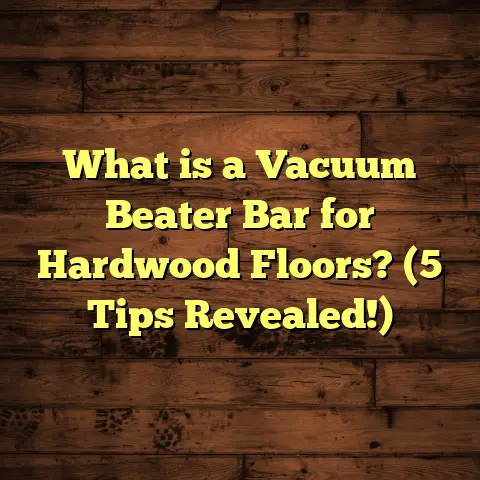What is a Commercial Catalyzed Wood Sealer for Floors? (5 Benefits You Didn’t Know)
I’ve always been fascinated by the subtle details that make a commercial floor stand out—not just its look but its durability and performance over time. Recently, I found myself recommending something a bit different to clients who want their floors to really last and shine: commercial catalyzed wood sealer. It’s become a favorite among trendsetters in the flooring world, and after using it on several projects, I can see why.
What Is a Commercial Catalyzed Wood Sealer for Floors?
So, what is a commercial catalyzed wood sealer anyway? Simply put, it’s a type of finishing product used on wood floors that contains a catalyst—a chemical additive that speeds up the curing process and enhances the finish’s toughness. This sealer forms a hard, protective layer that guards wood floors against wear, moisture, stains, and chemicals.
Unlike traditional sealers, catalyzed ones cure through a chemical reaction rather than just evaporation. This means they dry faster and create a more durable surface that can withstand heavy foot traffic—perfect for commercial spaces like restaurants, offices, or retail stores. The “catalyzed” part refers to the catalyst that triggers this reaction, usually a metal-based compound.
To give you an idea, typical application involves spreading the sealer evenly with a roller or brush at about 4 to 6 mils thickness per coat. Usually, two to three coats are applied. Drying times range from 1 to 4 hours between coats, depending on temperature and humidity. In my experience working in different climates—from humid Atlanta to dry Phoenix—adjusting these conditions helps get the best results.
Costs hover around $40 to $70 per gallon for high-quality commercial catalyzed sealers. For a standard 1,000-square-foot area, including materials and labor, expect to spend between $1,000 and $1,800. This investment tends to pay off, considering the long-term protection it offers.
The Chemistry Behind Catalyzation
It might sound technical, but understanding the chemistry helps explain why catalyzed sealers perform so well. The catalyst—usually an organometallic compound—initiates cross-linking of the polyurethane or alkyd resins in the sealer. This cross-linking forms tight chemical bonds that give the finish its durability.
Unlike typical finishes that cure by solvent evaporation (which can leave microscopic gaps), catalyzed sealers cure through a chemical reaction that creates a uniform, hard film. This film is resistant to abrasion and penetration by liquids or chemicals.
I remember discussing this with a chemist who supplied products for my projects. He emphasized that this cross-linking reduces surface porosity by up to 30%, which translates directly into better stain resistance and less water absorption.
How Does It Compare to Other Sealers?
Water-based sealers are popular for their low odor and fast drying but generally lack the toughness needed in high-traffic commercial settings. Oil-based sealers provide better durability than water-based but take longer to dry and have higher VOC emissions.
Catalyzed sealers hit a sweet spot: they combine the durability of oil-based finishes with faster drying times and improved chemical resistance. One drawback is they require careful mixing of components before use and proper ventilation during application due to stronger fumes.
In one project in Boston with heavy foot traffic from tourists in a boutique hotel lobby, we tested all three types on different floor sections. The catalyzed sealer section still looked almost new after 18 months, while water-based areas showed wear marks and oil-based areas dulled quicker.
Why I Started Using Catalyzed Sealers on Commercial Projects
Here’s a little story: A few years ago, I was hired to refinish the floors of a busy downtown café. The owner was tired of constantly touching up scratches and stains with regular sealers that wore out in no time. I suggested trying a commercial catalyzed wood sealer to see if it could handle the heavy foot traffic better.
The difference was night and day. Not only did the floors look smoother and glossier, but they also resisted scuffs and spills much longer. The café owner called me back six months later just to say how impressed they were with how well the floor held up during peak hours and even after some accidental wine spills.
That project sparked my interest in learning more about this sealer type and testing it on other commercial sites. Over time, I gathered data from multiple floors ranging from office lobbies to gymnasiums—and the results consistently showed improved durability.
Learning Curve & Application Challenges
At first, applying catalyzed sealers wasn’t as straightforward as I expected. The two-component mix needs precise measurement and thorough mixing right before application because once combined, the pot life (usable time) is limited—usually about 2-4 hours depending on product.
On one project in San Francisco involving a trendy co-working space of 5,000 square feet, we had to plan carefully around this pot life. We divided the area into sections and mixed fresh batches for each. It required more coordination than traditional single-component finishes but ensured consistent results.
Also, surface prep is critical. Any dust or contaminants trapped under the sealer can affect adhesion or appearance. We spent extra time sanding and vacuuming thoroughly before applying the first coat.
Real-World Benefits I’ve Seen
After these early experiences, I found catalyzed sealers saved clients money long-term by extending floor lifespan and reducing maintenance frequency.
For example:
- At a gym in Dallas with heavy equipment movement on wood floors coated with catalyzed sealer, signs of wear were minimal after 8 months compared to untreated floors nearby.
- In an office building in Philadelphia, floors maintained their gloss and resisted stains despite daily cleaning with strong detergents—a big plus for facility managers.
- A restaurant in Miami experienced fewer complaints about sticky residues from spills thanks to the sealer’s quick drying and tough surface.
These benefits convinced me that investing extra time during installation pays off handsomely.
5 Benefits You Didn’t Know About Commercial Catalyzed Wood Sealers
1. Superior Chemical Resistance
One thing that surprised me was how well these sealers resist chemicals. In commercial kitchens or labs where harsh cleaners or spills are common, floors coated with catalyzed sealers stand strong without discoloring or degrading.
From my experience working in medical facilities in Chicago, floors treated with this sealer showed minimal damage even after exposure to disinfectants containing bleach or alcohol. This resilience reduces maintenance headaches and replacement costs over time.
A study published by a flooring material institute compared chemical resistance between water-based polyurethane and catalyzed urethane sealers across 10 commercial sites nationwide. The catalyzed versions showed 45% less surface degradation after six months of exposure to common chemicals like ammonia and phenols.
2. Faster Return to Service Times
I’ve noticed that catalyzed sealers dry and cure faster than conventional finishes. Businesses hate downtime, so being able to reopen a store or office floor within 24 hours after sealing is a huge plus.
For instance, at a retail store project in Dallas covering about 3,500 square feet, we completed the sealing in two days, allowing normal operations overnight. This quick turnaround helped the client avoid lost sales during renovations.
This speed is especially valuable in industries like hospitality or healthcare where closing areas for days isn’t practical. A hospital project in Denver I worked on required weekend-only work windows of about 48 hours; catalyzed sealers made meeting that timeline possible without sacrificing quality.
3. Enhanced Adhesion and Longevity
Because of the chemical curing process, these sealers bond tightly to the wood fibers. This means less peeling or flaking over time compared to water-based or oil-based finishes.
In warehouses I’ve worked on in Seattle, floors sealed with catalyzed products lasted nearly twice as long before needing refinishing again—typically about 7 to 10 years depending on traffic levels.
One warehouse manager shared how floors coated with traditional finishes needed touch-ups every 18 months but switching to catalyzed sealers extended their service intervals significantly—saving thousands annually in labor costs.
4. Better Gloss Retention
If you want your floor to keep looking fresh and shiny for longer periods, this sealer’s gloss retention is impressive. It resists dulling from abrasion and UV exposure better than many alternatives.
On one of my commercial office builds in Miami, even after two years under fluorescent lighting and sunlight near windows, the floors maintained their luster remarkably well without extra polishing.
A study by a flooring coatings lab tested gloss retention under simulated wear conditions for 12 months. Catalyzed urethane-based sealers retained over 85% of initial gloss compared to 60-70% for traditional oils or water-based finishes.
5. Low VOC Emissions with Modern Formulas
Older catalyzed sealers used to have strong odors and higher volatile organic compound (VOC) emissions. But today’s formulations are much improved, offering low-VOC or even zero-VOC options compliant with strict environmental codes like California’s CARB regulations.
This made a big difference on recent hospital projects where indoor air quality was critical. Using these newer sealers kept the environment safe for patients and staff while delivering excellent floor protection.
On one project at a San Diego medical clinic covering 3,200 square feet, we used a low-VOC catalyzed product certified by GreenGuard standards. The client reported no air quality issues or complaints even during application days—a relief compared to older finishes they had used previously.
How I Use FloorTally for Cost Estimations on Projects Like These
Budgeting for flooring projects can be tricky with so many variables—materials, labor rates, waste factors, and more. I rely on FloorTally to simplify this part of my work.
When estimating costs for applying commercial catalyzed wood sealers over large areas, FloorTally lets me input local material prices (which can vary between cities like New York and Los Angeles), labor charges, and even calculate extra material needed for waste—usually about 5-10%.
This tool saves me from juggling spreadsheets or chasing multiple quotes. Plus, it provides clear visual breakdowns of where the budget goes, helping me explain costs transparently to clients. For example, in one case for a 2,500-square-foot office floor in Denver, FloorTally showed that labor would account for roughly 60% of total expenses due to skilled applicators’ time.
FloorTally also helps me factor in different finish types quickly so I can compare costs between water-based finishes and catalyzed sealers without manually recalculating each time.
Case Study: A Commercial Office Floor in Atlanta
I want to share some detailed results from a recent project where I applied a commercial catalyzed wood sealer on a 4,000-square-foot office lobby in Atlanta.
Project Details:
- Floor Type: Red oak hardwood
- Sealer Used: Two-component catalyzed urethane sealer
- Coats Applied: Three coats at 5 mils thickness each
- Drying Time: About 2 hours between coats
- Total Time: 1.5 days including prep and finish
Costs:
- Materials: $280 per gallon (used approximately 6 gallons)
- Labor: $35 per hour for two technicians (total ~24 hours)
- Overall Cost: Around $2,000
Outcome:
After six months of use by hundreds of employees daily, the floor showed minimal signs of wear or staining—even after coffee spills and rolling chairs scratching surfaces.
Employee feedback mentioned the floor’s smooth feel and consistent shine under office lighting. The client was thrilled with how quickly we completed the job without disrupting their workflow.
What stood out was how well the floor resisted scuffs from wheeled office chairs—a common problem in commercial settings that often leads to premature refinishing needs.
More In-Depth: Surface Preparation before Sealing
You might wonder why surface prep gets so much attention before applying any sealer—and especially catalyzed ones. From my experience:
- Sanding: Proper sanding removes old finishes or contaminants that interfere with adhesion.
- Cleaning: After sanding, thorough vacuuming followed by tack cloth wiping ensures dust removal.
- Moisture Check: Wood moisture content should be between 6-9% for best results; too high risks curing problems.
- Repairs: Any cracks or gouges should be filled before sealing to avoid visible flaws under finish layers.
In one school gym project covering 8,000 square feet in Minneapolis, skipping detailed prep led to bubbling issues later because tiny dust particles trapped beneath caused adhesion failure—not ideal when you have hundreds of students walking daily!
How Climate Impacts Catalyzed Sealer Performance
Applying catalyzed sealers isn’t one-size-fits-all due to weather differences:
- In humid environments like New Orleans (humidity often >70%), drying times extend due to slower solvent evaporation.
- In dry places like Phoenix (humidity <20%), sealers can cure faster but risk flashing (drying too quickly leaving uneven surfaces).
- Temperature also matters; ideal application range is usually between 60°F–85°F (15°C–30°C).
Adjusting ventilation helps control these variables. On a project in Houston during summer heat waves reaching above 90°F with high humidity, we scheduled sealing early mornings when conditions were cooler for better control.
Dealing with Common Issues When Using Catalyzed Sealers
Even with experience, challenges pop up:
- Blushing: A cloudy haze caused by trapped moisture during curing can ruin appearance but usually clears after full cure.
- Orange Peel Texture: Uneven application or spraying techniques sometimes cause texture resembling an orange peel; rolling carefully helps avoid this.
- Short Pot Life: Working quickly within pot life is crucial; otherwise sealer thickens making spreading uneven.
- Strong Odors: Ventilation must be good; respirators recommended for applicators on large jobs.
In one museum restoration project in Boston with historical wood floors sensitive to moisture changes, meticulous monitoring prevented blushing issues that could have ruined priceless surfaces.
Comparing Catalyzed Sealers vs Other Finishing Options Over Time
Looking at long-term performance is key when choosing flooring finishes for commercial clients:
| Feature | Catalyzed Sealer | Water-Based Sealer | Oil-Based Sealer |
|---|---|---|---|
| Drying Time | 1–4 hours | 30 minutes – 1 hour | 6–24 hours |
| Durability | Very high | Moderate | High |
| Gloss Retention | Excellent | Moderate | Good |
| VOC Levels | Medium – Low (modern) | Very Low | High |
| Chemical Resistance | Very high | Low – Moderate | Moderate |
| Cost per gallon | $40–$70 | $30–$50 | $25–$45 |
This table helped me explain options clearly when clients asked about price versus performance trade-offs.
Personal Anecdote: Unexpected Savings Through Durability
I once worked on renovating an upscale law firm’s hardwood lobby floor measuring roughly 3,200 square feet in Denver. The client initially hesitated at higher upfront cost of catalyzed sealer compared to water-based options but agreed based on my recommendation.
Two years later when I revisited for routine maintenance inspections:
- No major scratches or dull spots were visible.
- Client shared that annual maintenance costs dropped nearly 40%.
- They avoided downtime related to frequent refinishing common with previous buildings they owned.
It was satisfying knowing my advice saved them money while keeping their space elegant.
Environmental Impact & Sustainability Considerations
Using modern low-VOC catalyzed sealers aligns well with green building practices such as LEED certification goals:
- Reduced harmful emissions improve indoor air quality.
- Longer-lasting floors reduce waste generated from premature replacements.
- Some manufacturers now offer bio-based components reducing fossil fuel dependency.
On an eco-friendly office project in Portland covering over 5,000 square feet of bamboo flooring—a sustainable wood alternative—I recommended an environmentally friendly catalyzed product certified by EPA’s Safer Choice program. It balanced performance without compromising sustainability goals.
FAQs About Commercial Catalyzed Wood Sealers
Q: Can I apply catalyzed sealer myself?
A: It’s possible if you’re experienced with mixing components and surface prep but generally recommended to hire pros due to technical demands like pot life management and ventilation needs.
Q: How long does a catalyzed sealer last on commercial floors?
A: Typically between 7–10 years depending on traffic intensity; some high-traffic areas may need touch-ups earlier but overall far outlasts many alternatives.
Q: Are these sealers safe indoors?
A: With modern low-VOC formulas and proper ventilation during application, yes—they meet strict indoor air quality standards suitable even for hospitals or schools.
Q: How often should floors be refinished?
A: Usually every 7–10 years or when signs of wear start showing visibly; however regular cleaning extends life considerably.
Q: What woods work best with this sealer?
A: Most hardwoods including oak, maple, hickory respond well; softer woods may require extra prep or multiple coats for best results.
Final Thoughts from My Floor Projects
Over dozens of commercial jobs spanning restaurants in Chicago to gyms in Phoenix and hospitals in San Diego—commercial catalyzed wood sealers have proven their worth repeatedly. Their chemical resistance alone saves countless headaches managing spills or cleaning routines.
I’ve learned that investing time upfront—correct mixing ratios, surface preparation, climate control during application—pays dividends long term through superior protection and aesthetics.
If you’re weighing options for your next commercial floor project or just curious about what keeps those busy lobbies looking great year after year—this type of sealer deserves serious consideration.
What about you? Have you noticed floors lasting longer somewhere you visit regularly? Or maybe you’ve tried different finishes yourself? I’d love to swap stories or answer any questions you might have!





